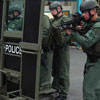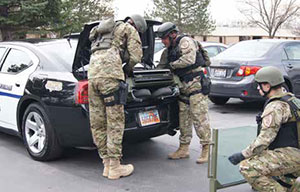
Operation Bunkers
First responders can make a difference if properly protected
- By Bob Bradshaw
- Apr 01, 2013

Portable bunkers provide first responders the ability to
make a difference in the early stages of critical crisis response.
If staged in schools, airports or a mall, these tools
become a needed resource for first responders regardless
of the level of training or the equipment they may have. Bunkers
have already been time-tested and have proven to be valuable assets
in the SWAT community for hostage negotiation, barricaded
subjects and crisis response.
Most critical response incidents occur before SWAT teams can
respond, illustrating how valuable portable bunkers become for first
responders in an effort to save lives, and in situations where assault
weapons, large-caliber rifles or armor-piercing bullets may be used.
Law enforcement agencies, particularly SWAT teams, often confront
armed and dangerous people. It is not unusual for these agencies
to be facing large-caliber rifle rounds, such as the 30-06 rifle
rounds, common in hunting and the military, and the .308, .223 and
the 7.62 x 39. Criminals also have been known to buy armor-piercing
rounds, available for purchase to civilians, such as in the North Hollywood
Bank of America shooting.
Many incidents—Sandy Hook, Northern Illinois University, Aurora Movie House, Virginia Tech University,
Red Lake High School, University
of Texas and Columbine—involve assault
weapons, such as the AR15 and the AK47.
There are more than 2.1 million AR-15s in
the United States today, and many are outfitted
with extended clips, allowing the shooter
up to 30 shots without reloading. AR-15’s can
fire up to 200 rounds per minute.
Body Armor
Although it is standard practice for law enforcement
to wear body armor, armor is
heavy and typically rated only for handguns.
While small armored plates are often worn
inside vests to protect vital areas of the body,
they offer limited protection, especially to
the lower torso, legs, feet, neck, head and
face. For example, a National Institute of
Justice (NIJ) level IIIA vest’s maximum rating
is for a limited number of shots from a
44 magnum handgun. Vests are bulky and
heavy, weighing about 40 pounds with front,
back and side plates. Because the armor must
not interfere with an officer’s agility, vests are
designed to be small and practical but limited
in coverage.
 In general terms, a “bulletproof” vest or
other armor will protect law enforcement
from the majority of handgun threats. However,
there is always a tradeoff between protection,
wearability and weight constraints. Body
armor is vulnerable by rifle rounds, unusually
high-velocity pistol ammunition, pistol
ammunition fired from a rifle barrel, armorpiercing
ammunition, sharp-edged or pointed
instruments and other unusual ammunition.
In general terms, a “bulletproof” vest or
other armor will protect law enforcement
from the majority of handgun threats. However,
there is always a tradeoff between protection,
wearability and weight constraints. Body
armor is vulnerable by rifle rounds, unusually
high-velocity pistol ammunition, pistol
ammunition fired from a rifle barrel, armorpiercing
ammunition, sharp-edged or pointed
instruments and other unusual ammunition.
At some angles, projectiles can slide,
deflect or ricochet off armor. Furthermore,
projectiles that are successfully stopped by
armor will always produce some level of injury—
bruising, broken bones, internal damage
and even death. While soft-body armor
defeats most pistol and shotgun projectiles,
no vest makes law enforcement invulnerable
to all threats.
The head is much more susceptible to
blunt trauma than the body. Although head
protection reduces the odds of serious injury,
helmets do not protect the face or neck. Any
impact of a bullet on a helmet can cause injury
or death, so, as with any armor, there is
no guarantee of invulnerability.
Personal shields may be used for more
protection. The shields are heavy, so they
are designed to cover only the vital areas of
the body and are usually only 16 inches x 38
inches. While shields provide an additional
layer of protection, most are only rated for
handguns and are difficult to carry long
distances because of their weight. To stop
armor-piercing rounds, even the smallest
shield would weigh more than 50 pounds
with a vision panel and battery-powered
light. The ability to manipulate a weapon is
also limited since at least one of the officer’s
hands is occupied carrying the shield.
The level of protection required for each
confrontation can vary widely. Agencies often
consider the 30-06, .308, .223, 7.62 x 39
and armor-piercing rounds as their most
serious threat. Furthermore, so personnel
can see adequately without unnecessarily
exposing themselves to danger, officers typically
need to be positioned within a distance
of about 30 yards. These requirements have
established a performance baseline for adequate
protection.
Bunker Benefits
Portable bunkers could be used in schools,
universities, and movie theaters by law enforcement
agencies, as well as the military,
secret service, homeland security and security
contractors. Mobile bunkers can be stored
in a closet or office. Collapsible bunkers that
have a low footprint can easily be stored under
a piece of furniture, in the trunk of a car,
the rear of an SUV or in an armored personnel
carrier (APC).
The mobile ballistic bunker is a rolling
shield on wheels that protects 100 percent of
a person’s body. The non-collapsible bunker
measures 22 inches x 75 inches and consists
of a lower panel and an upper section
of glass. The panels can be removed and replaced
if the panel or glass is shot. A hinged
apron at floor level provides ballistic protection
against low shots and skip rounds. The
hinges allow movement across irregular surfaces,
such as gravel, and the frame permits
the vertical stacking of panels and glass that
act as a full-body shield.
The collapsible bunker is similar in size
to the non-collapsible unit when standing.
However, it can be folded into a small bundle,
hidden under a coffee table or cabinet.
Since it is only 14-inches tall, the unit can
be transported easily. The caster-type wheels
have run-flat tires that permit the bunker to
be moved over rough terrain. The wheels,
which rotate 360 degrees, can be locked for
front-to-rear or lateral motion.
The ballistic bunker can be fully deployed
at a remote location, then rolled into
position, providing full-ballistic protection
during movement. Once in position, it is
free-standing and can pass through a 3-foot
doorway without exposing officers or compromising
its ballistic integrity.
For situations requiring broader ballistic
protection, two or more units can be latched
together. Removable panels can be easily
lifted onto the bunker to increase its width.
A standard twin bunker with all optional
panels measures more than 7 feet wide. Portable
bunkers are the next step in responder
protection.
This article originally appeared in the April 2013 issue of Security Today.